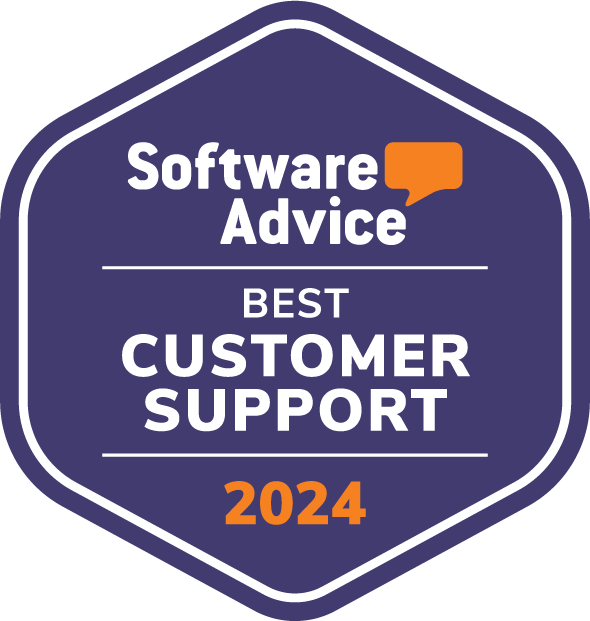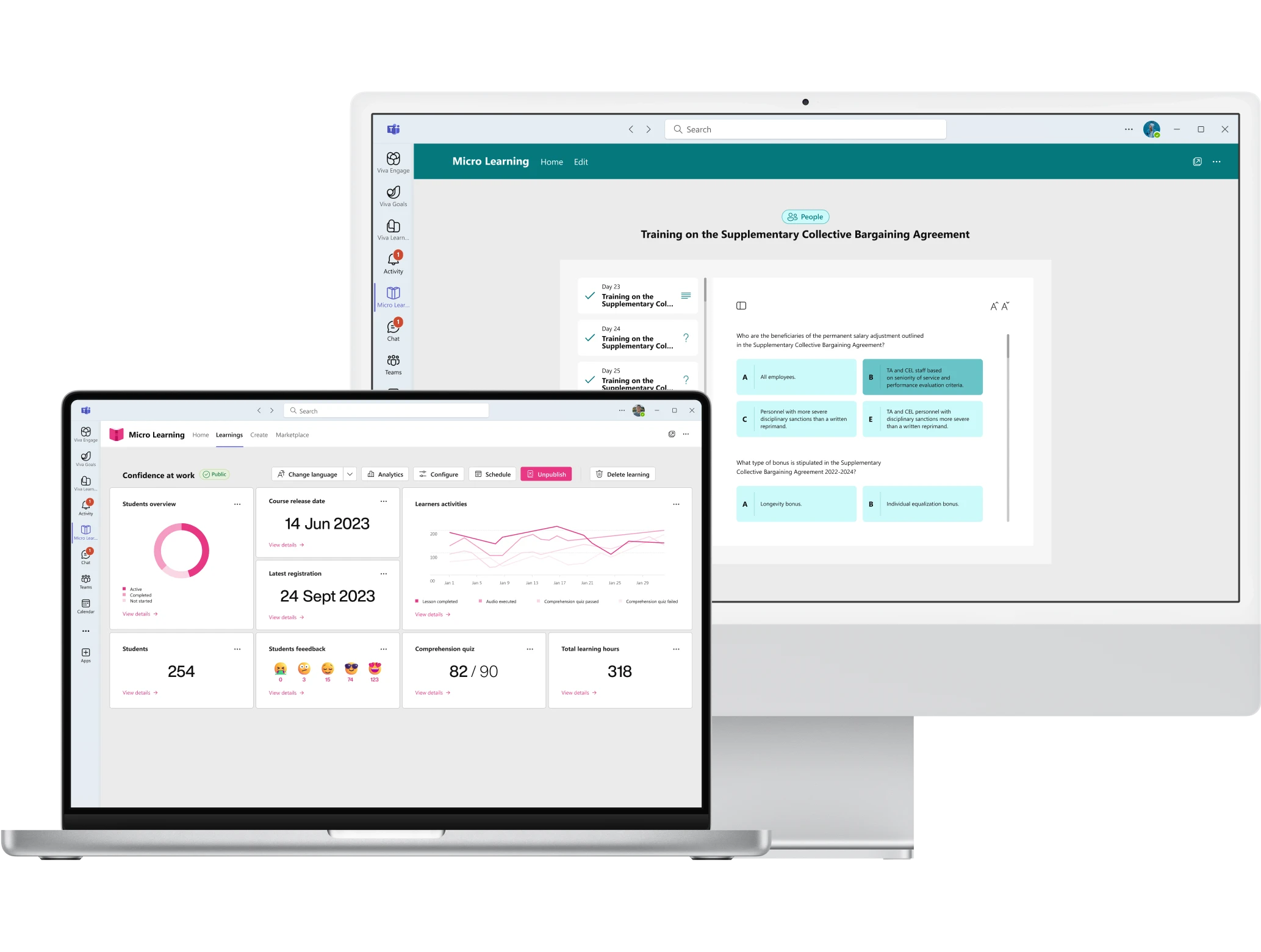Corporate training: How to manage it with Microsoft 365
Corporate training ensures continuous growth for both workers and the organization itself. In fact, companies that focus on updating internal skills gain a twofold advantage: the improvement of individual performance, of course, but also the creation of a more solid and competitive corporate culture based on innovation.
In this article, we are going to explore in detail the concept of corporate training, analyzing modern methodologies, objectives and the benefits it offers to professionals and businesses. We will also delve into how to structure an effective training plan, including through the adoption of specialized solutions such as those of Microsoft 365 and intranet.ai's Microlearning.

Corporate training: benefits and types
You never stop learning, goes a famous saying, and this truth is even more evident in the business world. Only those who invest in their own continuing education can evolve and secure a thriving professional career.
Corporate training, however, is not just a goal, but a strategic pillar through which to develop and renew internal skills on an ongoing basis, aligning them with a constantly changing market and organizational goals.
We are not simply talking about acquiring technical skills: from a company's point of view, investing in training means improving the performance of each worker and thus increasing the productivity of teams, investing in their growth.
From the worker's point of view, then, training helps to have greater confidence in one's role, keeping motivation high in contributing to the growth of a company where one's skills can be enhanced. For this very reason, people who receive quality training in their own company are less likely to seek opportunities elsewhere.
So let's look at how to offer workers the best training experience, starting with the first question a company might ask: What types of training currently exist?
We summarize them in the following table.
| Types of corporate training | Description |
| Technical | This is the most common type of training, focusing on specific skills related to daily work, such as the use of company software, machinery or procedures. |
| Transversal | This type of training aims to develop so-called "soft skills," among which we find effective communication, conflict management or problem solving. |
| Online | This is a flexible type of training, allowing courses and updates to be taken on busy work days. |
| In-person | More traditional mode of training, such as classroom or on-the-job. |
| Leadership-focused | Programs dedicated to training future managers, designed to prepare selected talent for roles of greater responsibility, giving them the tools they need to manage a team and make strategic decisions. |
So let's move on to the second question: How to implement each of these types of training in your company, delving into the solutions recommended by our experts.
| Types of corporate training | Recommended solutions |
| Technical |
|
| Transversal |
|
| Online |
|
| In-presence |
|
| Leadership-focused |
|
How to create a corporate training plan
It becomes clear that a well-structuredcorporate training plan is the key to optimizing investment in an organization's internal competencies.
The creation of such a plan always begins with a needs analysis. Each company should in fact understand what gaps are present and what priority should be assigned to each of these in order to create a truly effective training offering.
These needs can be identified through:
- surveys to be distributed to colleagues
- interviews with business team leaders
- analysis of the performance of individual departments
Once the main gaps have been identified, the objectives of the training plan need to be defined. These are goals that must be related to the growth of the company and the workers, of course, and some examples may be improving time management skills, reducing the number of errors in daily operations, or increasing the level of satisfaction of colleagues.
What is important is to ultimately have clear, specific and measurable goals.
The next step involves the selection of training methods, which depend on the goals and priorities identified earlier.
Some skills can be acquired easily through courses delivered online, while others may require a more hands-on approach, which could involve mentoring or coaching sessions in the workplace.
Let's try to think of a training plan designed for the Salesteam in an e-commerce company. The organization might realize that the department suffers from some critical issues, including difficulty in time management and a conversion rate for proposed contracts of 15 percent (significantly lower than the industry average of 25 percent).
Based on this data, the company might decide to create a targeted training course for its Sales team.

Therefore, it is necessary to first understand the causes of the difficulties.
Through a survey of team members, it might emerge that many of them struggle to use the corporate CRM. In addition, an interview with the manager might confirm that salespeople often focus on non-priority tasks and that this takes away from their valuable time to work on negotiations.
From this analysis, areas for improvement and objectives on which to base the training plan clearly emerge. By formulating the objectives correctly, the plan would serve to increase the conversion rate by 10 percentage points within a six-month period and reduce the average time needed to close a contract from 7 to 4 days.
Here is an example of how to apply the different internal training methodologies to the plan in question:
- Technical training: delivery of an online course on corporate CRM, including practical exercises.
- Soft skill development: organization of a workshop, lasting two days, dedicated to time management and negotiation.
- On-the-job training: shadowing a more experienced mentor during negotiations to practice what was learned and correct any misbehavior immediately.
At this point, the company might decide to structure the training plan in three phases, to be spread over a two-month period.
| Timeline for internal training | Planned activities and objectives |
| Week 1-2 | The Sales team participates in an e-learning course on the company's CRM, devoting one hour a day to the training and exercises planned to consolidate the technical skills acquired. |
| Week 3 | A classroom workshop is organized, focusing on improving negotiation techniques and time management. |
| Week 4-8 | Salespeople are paired with a mentor to improve negotiation management, receiving immediate feedback. |
Course delivery is via Microsoft Viva Learning, which allows the team leader to monitor progress and deadlines in real time. The workshop, on the other hand, takes place in the company and should be conducted by a specialized external trainer.
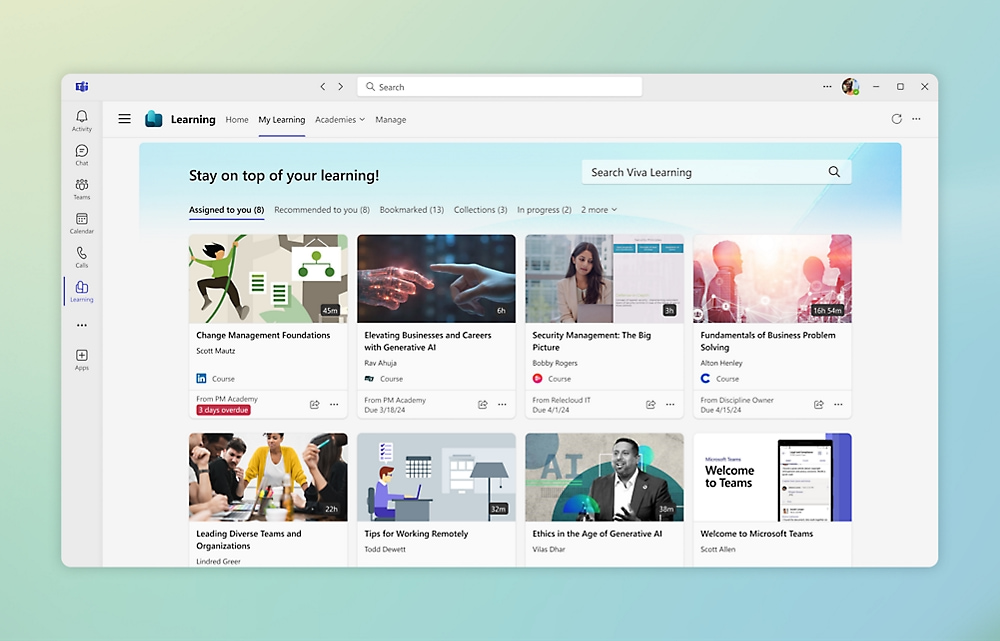
Microsoft Viva Learning interface
To ensure the effectiveness of the plan, there should be evaluation activities for each phase, both during the training (through quizzes and role-play sessions) and afterwards (through an analysis of sales metrics) to measure the impact of the training plan in terms of contract conversion and closing.
Internal corporate training: What distinguishes it from external training?
Internal training has many advantages over its counterpart managed by professionals outside the organization, although it involves some additional issues that should not be underestimated.
But let's start with the advantages.
Among the main ones, we find responsiveness to the real needs of the people who are part of the company, to whom an attempt is made to offer a personalized practical solution in the form of exercises, workshops and resources dedicated to best practices and use cases.
This aspect differentiates it from certain types of external training, where a more academic focus causes the experience to be broader in scope and, at times, overly theoretical. In-house training is therefore particularly useful for learning how to deal with the daily challenges faced by one's colleagues, professionally and otherwise.
Another advantage concerns the guarantee of continuity. In-house training makes it possible to develop a growth path tailored to workers, who are thus more likely to stay with a company that invests in their professional careers.
However, as we said, a training path managed exclusively within a company has some problems. First and foremost is the lack of objectivity.
Since the material is created by the company itself, the training experience may be limited and less objective, leading to a narrower view of the real issues that prevent the maintenance of optimal performance.
Here, then, many organizations are choosing to take a hybrid approach to training, that is, to supplement their own resources and courses with content offered by external providers and with the support of outside trainers who can contribute an unbiased viewpoint.
The intranet.ai team offers specific consulting sessions to help companies optimize their use of Microsoft technology, helping users improve productivity in their daily work apps and create a digital workplace that truly meets their needs.
In addition to live streaming training sessions, we provide ready-to-use content designed to learn how to use Microsoft 365 apps every day, along with the capabilities of the newly integrated artificial intelligence: Microsoft 365 Copilot.
Through a combination of both approaches to training-internal and external-any company can contribute to the development of its talent and lay the necessary foundation for sustained growth, including through the contribution of specialized external professionals.
Corporate training plan: examples of implementation with Microsoft 365
As we have seen in this brief overview, any corporate training program always starts with identifying needs, which means identifying the gaps that are hurting the productivity of individual teams.
As a professional productivity and communication suite, Microsoft 365 offers important tools to enhance the corporate training experience by turning feedback from colleagues into concrete actions to be included in one's plan.
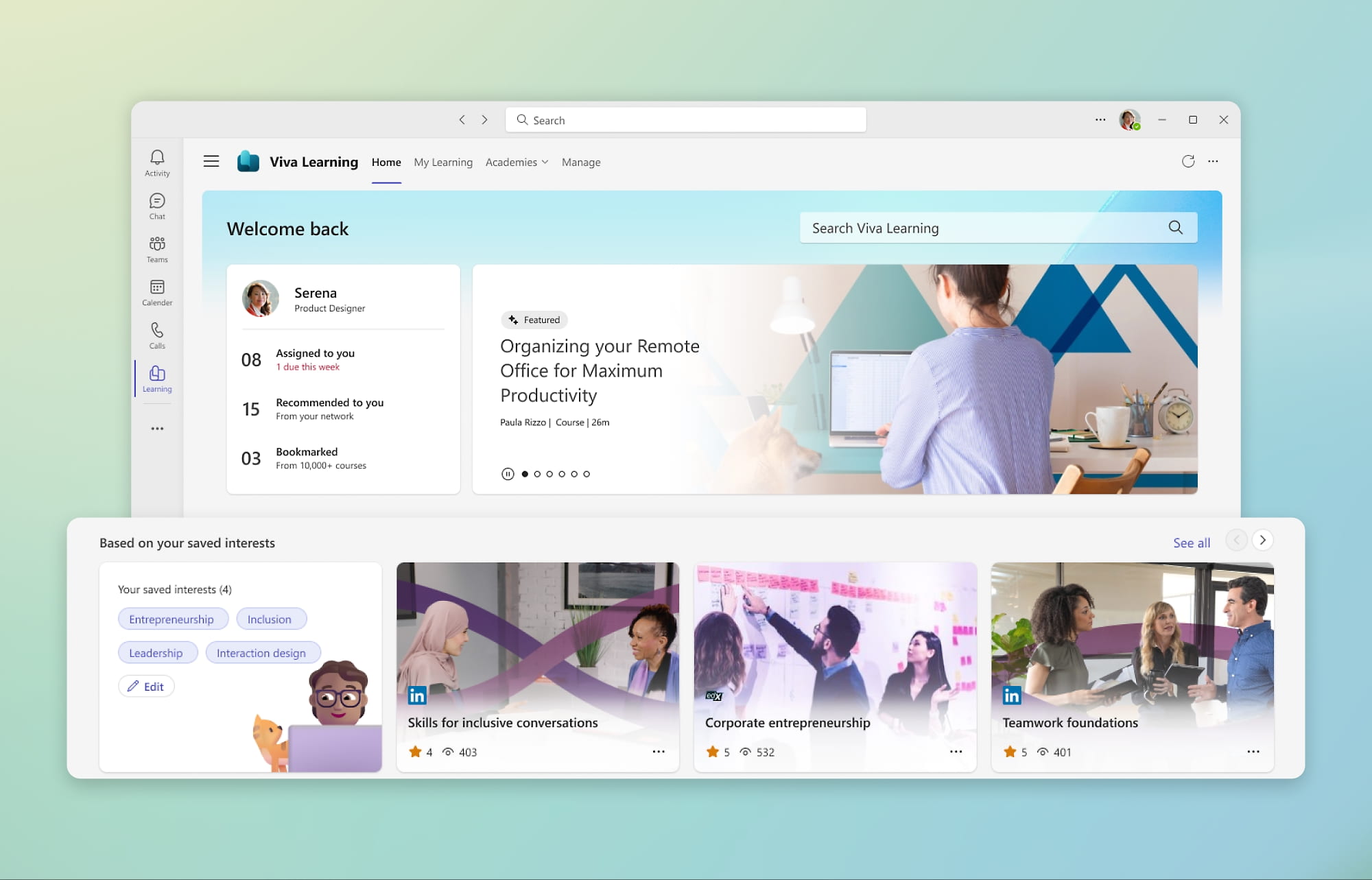
Recommended courses based on your interests in Microsoft Viva Learning
After identifying skills that are missing or in need of reinforcement, the company can proceed with content creation and distribution of relevant training materials for each team member. Content creation can take place in a variety of formats-from online courses toclassroom sessions, as we have seen, to newer solutions such as Viva Learning's Learning Paths.
These are customized Learning Paths that allow training content selected by the company to be organized in a logical sequence. Learning Paths can also integrate courses and resources from different platforms, such as the company intranet, based SharePoint Online, to centralize the training experience.
With this solution, it is possible to track skills acquired, identify areas still needing improvement, and track goal completion, all within the Microsoft 365 ecosystem.
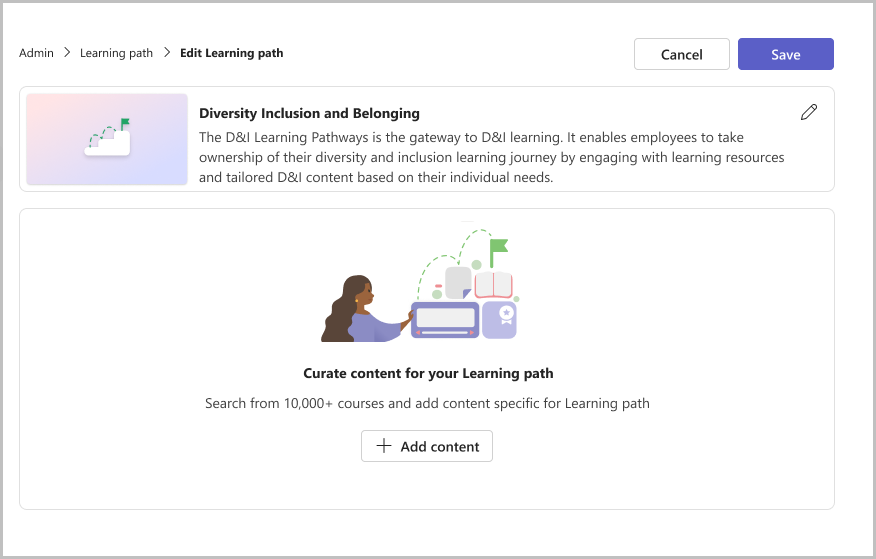
Creating a Learning Path in Microsoft Viva Learning
Obviously, the right format must be chosen for the situation.
On-the-job training or through mentoring is an advisable option for developing technical skills with the guidance of more experienced trainers and colleagues. For more theoretical knowledge or more structured skills, online courses, usable through Microsoft Teams and Viva Learning, are a viable alternative, because they allow you to integrate live sessions with on-demand content, meeting the need for greater flexibility.
Finally, one must not forget to involve colleagues so that (their) training is successful. In this regard, Microsoft applications encourage the creation of a collaborative environment where resource sharing, knowledge exchange and dialogue become central to training.
A star application here is Microsoft Teams, which can be used to stimulate a conversation during courses, allowing participants to exchange ideas, questions and answers. Teams can also become the platform for delivering live training sessions in order to foster discussion and organize group meetings during or after courses.
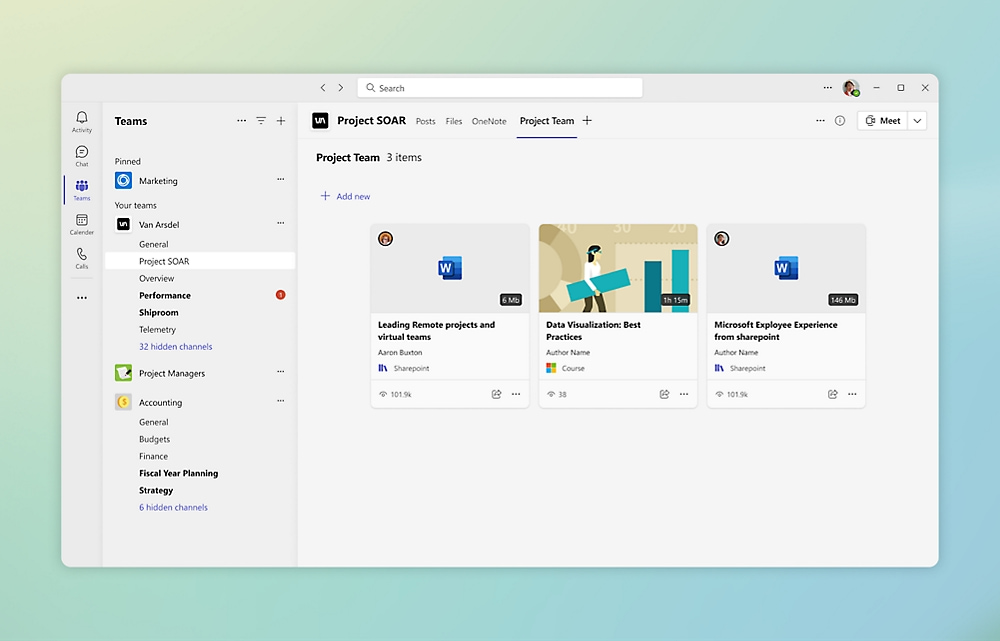
Simplifying access to training content in Microsoft Teams
Having arrived at a certain point in the training course, it will be necessary to evaluate the progress each one has made. Microsoft Viva Learning makes it possible to integrate quizzes and questions during or at the end of the modules that make up a course, to assess the level of understanding of the topics covered.
In addition to measuring individual progress, it is also necessary to ensure that training resources are easily accessible and always up-to-date: therefore, it is necessary to centralize and organize materials efficiently. With SharePoint Online, for example, companies can create an area within their intranet with training materials, which can be divided by topic or department they target.
SharePoint is also a great platform for managing internal training because it integrates natively with the remaining Microsoft 365 applications, including the aforementioned Teams and Viva Learning.
The integration between SharePoint and Teams, in particular, provides better accessibility. Not only can content be shared in groups and chats, but push notifications can be integrated to alert specific users or the entire corporate audience about the publication of new content.
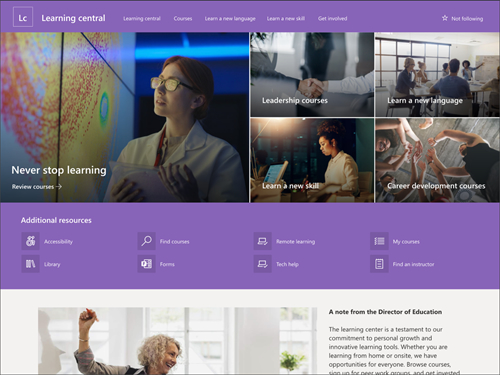
Training area on the SharePoint Online intranet
But let's look in detail at how to use the tools offered by Microsoft 365 to manage and implement an enterprise training plan, with some practical examples.
1. Onboarding training with Teams and SharePoint
Let's imagine a company that is implementing an onboarding program for new hires. Using Microsoft Teams, the company can create a dedicated channel just for onboarding, where informational materials (company mission, internal policies, roles, etc.) are uploaded. In this way, new colleagues can consult the content at any time, without wasting time searching for the information they need to get started.
SharePoint, on the other hand, can be used to centralize onboarding-related documents, allowing those who have just joined the company to easily access resources, FAQs and any guides specific to their role.
With the ability to set up a dedicated SharePoint site, the company can organize materials by department, making the experience even more personalized.
2. Skills update with Viva Learning
Another use case involves in-process training, where refresher courses stand out. With Viva Learning, a company can create customized learning paths based on the roles and needs of the members that make up a team.
For example, Sales team members could access courses related to advanced sales techniques, to deal with complex negotiations, or objection handling, to improve skills in responding to all possible customer questions. In addition, this platform makes it possible to combine internal and external training, bringing together courses developed by the company or its partners.
3. Coaching and mentoring with Teams and Viva Engage
A company could use Teams to organize one-on-one sessions, where the worker and assigned mentor have the opportunity to discuss the goals to be achieved at the end of the training and how to proceed to best develop the required skills.
In addition, the use of Viva Engage can foster the creation of a learning community, where information, experiences and resources can be shared through features that are typical of social media and, therefore, more engaging than traditional forms of communication.
4. Tracking results with Forms and Power BI
A company offering compliance training could use Microsoft Forms to collect feedback from participants at the end of the course. Users could share their opinion on the quality of the content made available and how it was delivered, thus contributing to the improvement of the company's training offerings.
Subsequently, KPIs related to compliance improvement, such as reduced errors in handling personal data or increased reporting of workplace incidents, could be tracked through Power BI, which would provide managers with analysis on the impact of the courses.
5. Management training with SharePoint and Teams
In the case of corporate manager training, a dedicated leadership development course could be created by leveraging the combination of SharePoint and Teams. Managers could then access courses and participate in live webinars through Teams, and then consult in-depth resources on the SharePoint site linked to the group.
Do you want a complete, ready-to-use intranet?
intranet.ai is the SharePoint Online-based solution for simplifying internal communication and digitizing business processes with minimal investment of time and money.
- 50+ features for communication and employee experience
- Branded design, customizable in every detail
- Full integration with Microsoft 365 and Viva
Giuseppe Marchi
Microsoft MVP for SharePoint and Microsoft 365 since 2010.
Giuseppe is the founder of intranet.ai and one of the top experts in Italy for all things Microsoft 365. For years, he has been helping companies build their digital workspace on Microsoft's cloud, curating the people experience.
He organizes monthly online events to update customers on what's new in Microsoft 365 and help them get the most out of their digital workplace.

FAQ on corporate training
What is corporate training?
Corporate training is a strategic process aimed at developing and updating employees' skills to align them with market demands and organizational goals. This approach helps improve individual and collective performance, fostering the overall growth of the company.
What are the benefits of corporate training?
Corporate training improves employee performance, increases team productivity, boosts motivation and job satisfaction, reduces staff turnover, and promotes a company culture centered on innovation.
What are the main types of corporate training?
The main types include technical training, which focuses on role-specific skills; behavioral training, which develops soft skills such as communication and leadership; mandatory training, covering regulatory and safety aspects; and managerial training, aimed at enhancing management and coordination capabilities.
How do you create an effective corporate training plan?
To develop an effective plan, it is necessary to analyze training needs by identifying required skills, define clear and measurable objectives, select suitable learning methods such as in-person or online training, plan activities and resources, and evaluate results through participant feedback and progress monitoring.
What is the difference between internal and external training?
Internal training is managed directly by the company, often using internal resources and expertise, while external training relies on professionals or specialized organizations. The choice depends on the complexity of the required skills and the available company resources.
How can Microsoft 365 support corporate training?
Microsoft 365 supports corporate training with tools like Microsoft Teams, which enables organizing online sessions and fostering collaboration, and SharePoint, which allows the creation and centralized sharing of training materials. Additionally, features like Microlearning from intranet.ai make it possible to integrate training snippets directly into the company intranet, ensuring continuous and integrated learning.
Keep on reading
Employee Onboarding Process: Our Checklist to Implement It

What is the employee onboarding process? Why is it essential? Here are the key steps and examples to implement it and gain the maximum benefits.
What Is Microlearning and How to Bring It in Your Company

Microlearning is a methodology that simplifies learning through short interactive learning units. Here's how and why to use it in your company.
SharePoint Online: What It Is, What It Is For, and 7 Key Features

SharePoint is the Microsoft 365 platform for document management and the creation of corporate sites. Here are its 7 main features.
